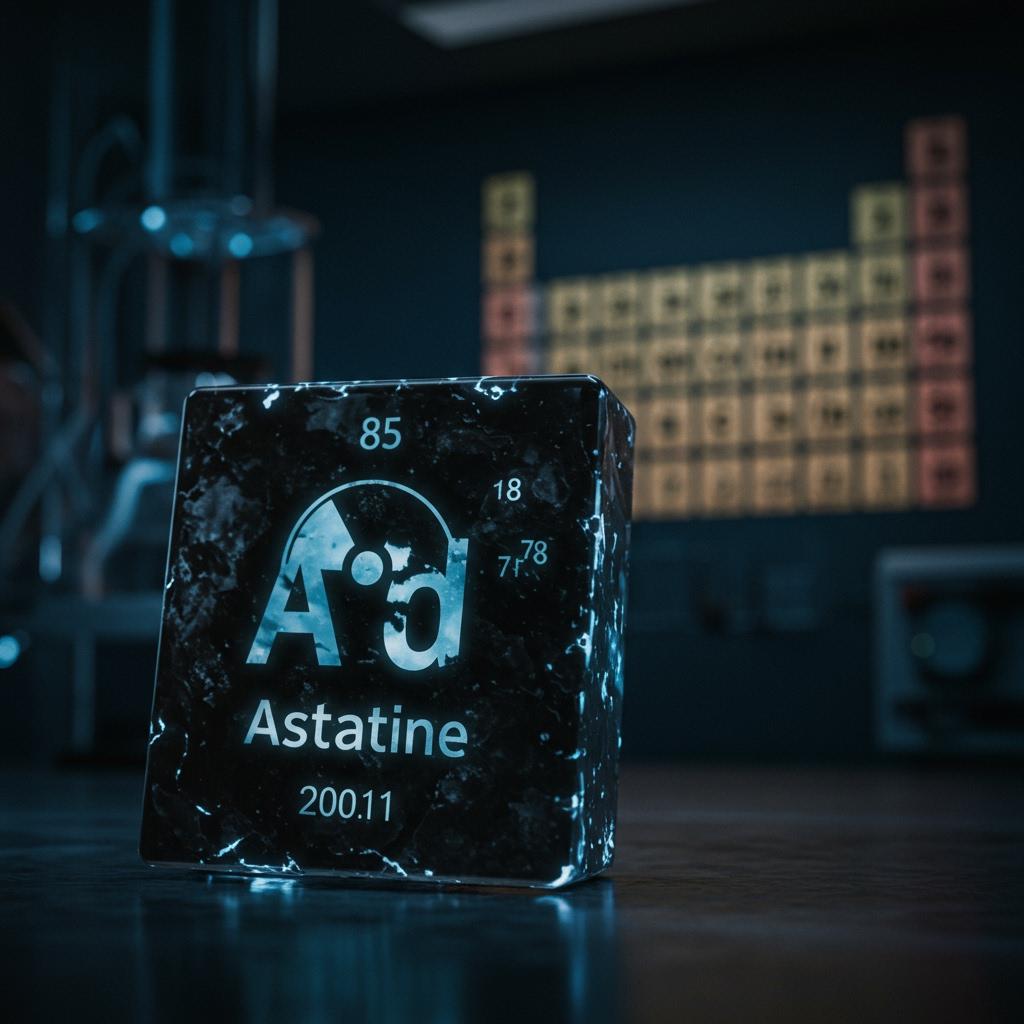The Weirdest Element You’ve Never Heard Of: Astatine
 Astatine, element 85, is the rarest naturally occurring element on Earth and one of the most mysterious members of the halogen family.
Astatine, element 85, is the rarest naturally occurring element on Earth and one of the most mysterious members of the halogen family.
By Peter Teoh, Science Writer
Introduction Imagine an element so rare that only about 25 grams exist naturally on Earth at any time. Astatine, the 85th element on the periodic table, is just that — a mysterious, radioactive halogen that barely makes an appearance in nature but sparks big questions about chemistry and physics. Let’s dive into the story of this elusive element, why it’s so weird, and what makes it fascinating for scientists and curious minds alike.
What Is Astatine?
Astatine (symbol At) sits in Group 17 of the periodic table, known as the halogens — a family that includes fluorine, chlorine, bromine, and iodine. These elements typically share similar chemical behaviors, but astatine is the heaviest and rarest halogen, making it truly unique. It has an atomic number of 85, which means its atoms have 85 protons.
Unlike its lighter siblings, astatine is highly radioactive, and all its isotopes (versions of atoms with different numbers of neutrons) are unstable. The most stable isotope, astatine-210, has a half-life of only about 8 hours, meaning it rapidly decays into other elements[2][5][6]. This extreme rarity and radioactivity mean no one has ever seen a chunk of astatine with the naked eye — any sample would vaporize from its own radioactive heat.
Where Does Astatine Come From?
Astatine is not found freely in nature. Instead, it forms as a tiny byproduct when heavier elements like uranium and thorium break down. Because it decays so fast, only tiny traces exist in the Earth’s crust at a time — scientists estimate just around 25 grams total across the whole planet[3][6].
Scientists can also create astatine artificially by bombarding bismuth-209 with alpha particles (helium nuclei), producing astatine-211, an isotope useful in research and medicine[1][5].
What Does Astatine Look Like?
Because astatine is so rare and radioactive, its physical properties are mostly predicted rather than observed. Scientists think it is a dark, possibly black or metallic-looking solid at room temperature, unlike the gaseous or liquid states of lighter halogens. It may even behave partly like a metal, which is unusual for halogens[2][5][6].
Chemical and Physical Properties
Astatine shares many chemical traits with iodine but also displays some unique features. It can form compounds similar to those of other halogens, like hydrogen astatide, which dissolves in water. However, its chemistry is complicated by its radioactivity and its borderline metal-nonmetal character.
Its electron configuration is [Xe] 4f14 5d10 6s2 6p5, placing it firmly in the p-block of the periodic table. It exhibits multiple oxidation states, including -1, +1, +3, +5, and +7, showing versatility in chemical reactions[2][8].
Why Is Astatine Important?
Though it sounds like a science fiction element, astatine has some real-world applications, especially in nuclear medicine. The isotope astatine-211 emits alpha particles — a type of radiation that can destroy cancer cells with precision, making it promising for targeted cancer therapies, particularly for thyroid cancer[1][6].
Because it mimics iodine’s behavior, astatine can accumulate in the thyroid gland, delivering radiation directly to cancerous tissue without widespread damage[6]. However, its extreme rarity means these treatments are still largely experimental and limited to specialized facilities.
The Discovery and Name
Astatine was first synthesized in 1940 by a team of American chemists led by Emilio Segrè at the University of California, Berkeley[3][5]. Its name comes from the Greek word ástatos (ἄστατος), meaning “unstable,” reflecting its brief existence and radioactive nature.
The Weirdness Factor
Astatine’s weirdness comes from its combination of being a halogen and a borderline metal, its extreme rarity, and how little we actually know about it. Its rapid decay means most of what we understand is based on predictions, experiments with tiny amounts, or comparisons with other halogens. It challenges scientists to push the limits of chemistry and nuclear physics.
Closing Thoughts
Astatine is a fascinating element that hides in the shadows of the periodic table. Its rarity and radioactivity have kept it mostly out of sight, but its potential in medicine and its unique chemistry make it a star in scientific research. For teenagers curious about the building blocks of our world, astatine is a perfect example of how much there still is to discover — even in the tiniest, most elusive substances.
Side Notes
- Isotopes: Astatine has about 20 known isotopes. The most studied are astatine-210 and astatine-211.
- Radioactivity: All astatine isotopes are radioactive, with half-lives ranging from milliseconds to hours.
- Safety: Due to its radioactivity, astatine is extremely hazardous and handled only in specialized labs.
- Physical State: Predicted to be a solid with metallic properties, but no one has seen a sample large enough to confirm.
Trending Sidebar: Cool Facts About Halogens
- Halogens mean “salt-formers” because they often react with metals to create salts.
- Fluorine is the most reactive element on the periodic table.
- Iodine is essential for human health, helping your thyroid function properly.
- Astatine is the heaviest halogen and might be a metalloid, blurring lines between metals and nonmetals.
References
- Vedantu: Astatine: Properties, Uses, Isotopes & Facts
- Science Notes: Astatine Facts – The Rarest Natural Element
- DIY.org: Astatine Facts For Kids
- Live Science: Facts About Astatine
- Wikipedia: Astatine